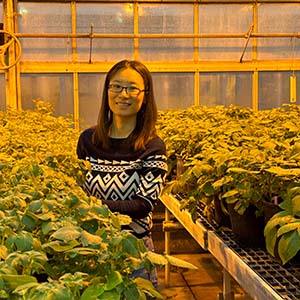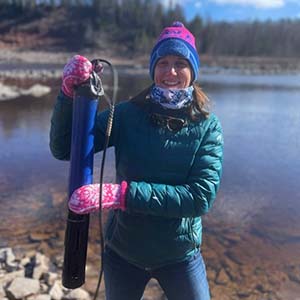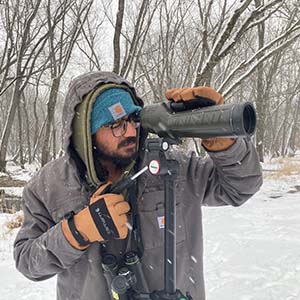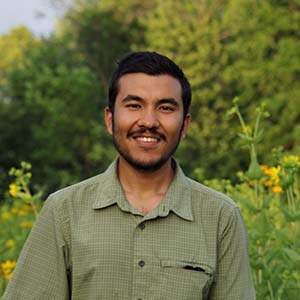These talks, held both days of the Spring Symposium, provide an opportunity for ecology-focused graduate students and postdoctoral scientists to share their research.
Linking Soil Microbial Community Structure to Disease Suppression and Growth Promotion
Dr. Shan Shan, Department of Plant Pathology
 The soil microbiome provides essential services in agroecosystems that can increase plant health and productivity, such as disease suppression and growth promotion. A small number of microbial groups have been proposed as main players behind disease suppression, but the complete picture of the underlying mechanisms remains unclear for both functions in many soil systems. Here, we investigated broad and fine scale microbial community features for their contributions to disease suppression and growth promotion for potato plants.
The soil microbiome provides essential services in agroecosystems that can increase plant health and productivity, such as disease suppression and growth promotion. A small number of microbial groups have been proposed as main players behind disease suppression, but the complete picture of the underlying mechanisms remains unclear for both functions in many soil systems. Here, we investigated broad and fine scale microbial community features for their contributions to disease suppression and growth promotion for potato plants.
In a greenhouse study, we grew potato plants in pots sharing a common background soil and inoculated with living soil microbial communities with or without a separate inoculation with Streptomyces scabiei, the causal agent of potato common scab disease. The suppression of common scab and growth promotion abilities of a variety of soil microbial communities were estimated and related to quantitative patterns in microbial community structure. We found that suppression of common scab was mostly driven by fine-scale microbial community features, especially the diversity within the Actinomycetota phylum.
Even though opposing components of microbial community structure might be related to the two functions, disease suppression did not cause a negative tradeoff in growth promotion. This suggests high functional redundancy in growth promotion. It may be possible to improve the multi-functionality of soil microbial communities by engineering the communities towards optimized disease suppression and growth promotion ability.
Exploring River Salinization Dynamics: Insights from Data-Driven Modeling
Lindsay Platt, Center for Limnology
 Long-term increases in salinization can disrupt ecosystem processes such as aquatic organismal development, replenishment of dissolved oxygen during periods of lake mixing, and biogeochemical cycling. In contrast, short-term fluxes in salinity from extreme events can also threaten ecosystem health due to the abrupt changes in environmental conditions and the sensitivity of many aquatic organisms to such swings. The speed, timing, and magnitude of salt transport through a watershed can be influenced by a variety of land uses, hydrologic features, and soil characteristics.
Long-term increases in salinization can disrupt ecosystem processes such as aquatic organismal development, replenishment of dissolved oxygen during periods of lake mixing, and biogeochemical cycling. In contrast, short-term fluxes in salinity from extreme events can also threaten ecosystem health due to the abrupt changes in environmental conditions and the sensitivity of many aquatic organisms to such swings. The speed, timing, and magnitude of salt transport through a watershed can be influenced by a variety of land uses, hydrologic features, and soil characteristics.
In this study, we explored watershed characteristics that may exacerbate or buffer the impact of road salt on rivers in the northeast and midwest United States at 122 different sites. We focused on two salinization mechanisms contributing to in-situ dynamics observed in long-term records: “episodic salinization” resulting from the rapid flushing of salts after a winter storm, and “baseflow salinization” resulting from salt retention and release through subsurface flow paths. We found that under similar road salt application rates, sites exhibit different salinization dynamics due to differences in groundwater influence, hydrology, and land use.
The results of this study add to the growing body of research characterizing the spatiotemporal extent and severity of freshwater salinization due to winter road salting, and gives us tools to identify at-risk rivers in order to improve management of roadways during winter months and better balance human safety with ecosystem health.
Carbon Finance Initiative Provides Biodiversity Benefits Through Reduced Deforestation and Hunting
Sathya Chandra Sagar HS, Department of Forest and Wildlife Ecology
 Revenues from carbon finance such as through REDD+, designed to mitigate climate change provide an exciting opportunity to protect tropical forest biodiversity, although conserving carbon does not necessarily conserve biodiversity. We evaluated the biodiversity co-benefits of the Gola-REDD+ initiative in Sierra Leone, under a causal inference framework.
Revenues from carbon finance such as through REDD+, designed to mitigate climate change provide an exciting opportunity to protect tropical forest biodiversity, although conserving carbon does not necessarily conserve biodiversity. We evaluated the biodiversity co-benefits of the Gola-REDD+ initiative in Sierra Leone, under a causal inference framework.
We used a combination of bioacoustic, invertebrate-DNA, to evaluate the efficacy of Gola-REDD+ in protecting biodiversity by asking two questions: (1) Was designating and managing forests as a protected area (PA) financed through the Gola-REDD+ (Treatment-PA) beneficial for biodiversity, compared to the alternative scenario of multiple-use community forests (Control-CF); and (2) Has Treatment-PA been effective in safeguarding biodiversity compared to a protected area, that lacks the financial means or resources from REDD+ (Control-PA).
We found soundscape saturation within the Treatment-PA to be significantly different, and more pronounced, when compared to Control-CF. We also found a conspicuous discontinuity in soundscape saturation at the boundary between Treatment- PA and Control-CF. We found the overall arthropod community to be significantly different between Treatment-PA and Control-CF. Similarly, we observed a distinct difference in the daily soundscape pattern between Treatment-PA and Control-PA, primarily attributed to the presence of hunting pressure within the Control-PA.
Our project provides important evidence on the effectiveness of a carbon finance project to serve the dual objective of conserving globally threatened biodiversity whilst banking carbon. We also provide a replicable study design following a causal inference framework, which could be used by other observational field studies evaluating the biodiversity co-benefits of conservation strategies.
Evaluation of Camelina Sativa Management as a Winter Cover Crop to Support Wild Pollinators in Wisconsin
Eliza Pessereau, Department of Entomology
 Cover crops are of increasing interest as agricultural conservation practices because of their benefits for soil health. In recent years, flowering cover crops such as winter camelina (Camelina sativa) have been used to provide food for pollinators on agricultural land, especially in early spring when floral resources are scarce. However, the amount and length of time that floral cover is available, as well as the practicality of camelina in forage cropping systems, depends greatly on fall planting date and cover crop mix.
Cover crops are of increasing interest as agricultural conservation practices because of their benefits for soil health. In recent years, flowering cover crops such as winter camelina (Camelina sativa) have been used to provide food for pollinators on agricultural land, especially in early spring when floral resources are scarce. However, the amount and length of time that floral cover is available, as well as the practicality of camelina in forage cropping systems, depends greatly on fall planting date and cover crop mix.
In this study we used a plot-scale randomized block experiment to measure the spring floral cover and subsequent pollinator visitation to winter camelina and uncultivated flowers (i.e. “weeds”) across 2 years in 3 cover crop mixes and 3 camelina monoculture fall planting dates, compared to an unseeded control. Cover crop mixes and camelina in monoculture planted at the same time all provided equal amounts of floral cover and supported comparable insect visitation rates the following spring. Monocultures of camelina planted earlier in the fall had the highest spring camelina floral cover, but dandelion provided floral cover in late-planting or unseeded treatments.
Despite the large proportion of total floral cover attributed to dandelion in many plots, pollinator visitation only increased with increasing camelina floral cover, although there may be a saturation point at which adding more camelina does not increase visitation. This study demonstrates that winter camelina can provide abundant resources for pollinators in early spring when planted in a monoculture or mix before the previous October.
The Effects of Conservation on Water Quality
Ngoc Ha Do, Department of Agricultural and Applied Economics
 Non-point source pollution remains one of the leading causes of water problems in the US. Latest assessments from the Environmental Protection Agency (EPA) have shown that almost half of US rivers, streams, and lakes are impaired by nutrients, and the number of lakes with good oxygen levels has decreased significantly over time. Since agriculture accounts for a significant share of non-point source pollution, to improve water quality, in the US, many conservation programs have been created. Findings on the effects of these programs on water quality, however, have been limited.
Non-point source pollution remains one of the leading causes of water problems in the US. Latest assessments from the Environmental Protection Agency (EPA) have shown that almost half of US rivers, streams, and lakes are impaired by nutrients, and the number of lakes with good oxygen levels has decreased significantly over time. Since agriculture accounts for a significant share of non-point source pollution, to improve water quality, in the US, many conservation programs have been created. Findings on the effects of these programs on water quality, however, have been limited.
In this paper, I evaluate the effects of the Conservation Reserve Enhancement Program (CREP) on water quality in Wisconsin. Using a rich dataset of seven water quality indicators and information on CREP contracts, I develop different causal frameworks to quantify these effects. In my preferred specifications, conservation reduces nutrient runoff (nitrogen), biochemical oxygen demand, and fecal coliform. Enrolling cropland in CREP also increases dissolved oxygen levels. However, in most specifications, I find none or very little effects of CREP on phosphorus, pH, and suspended solids.
Further analyses reveal that the effects of CREP on water quality differ across physical and hydrological characteristics, climate conditions, and socioeconomic conditions of each sub-watershed. This study contributes to the understanding of the effectiveness of non-point source pollution policies and conservation policies.
Drivers of Population Genetic Structure in an Archipelagic Red-Backed Vole Population in Wisconsin’s Apostle Islands
Bijit Khadka, Forest and Wildlife Ecology
 Rapid environmental change reshapes ecosystems and drives extirpations globally, prompting the identification of ecological refugia, areas with historical characteristics, resistance to environmental change, and potential connectivity. The Apostle Islands (Lake Superior, USA) are likely refugia due to structurally complex forests and buffering from climate change. Notably, southern red-backed voles (M. gapperi) remain abundant on islands, despite regional declines. However, fundamental population attributes including connectivity, genetic and demographic potential remain unknown.
Rapid environmental change reshapes ecosystems and drives extirpations globally, prompting the identification of ecological refugia, areas with historical characteristics, resistance to environmental change, and potential connectivity. The Apostle Islands (Lake Superior, USA) are likely refugia due to structurally complex forests and buffering from climate change. Notably, southern red-backed voles (M. gapperi) remain abundant on islands, despite regional declines. However, fundamental population attributes including connectivity, genetic and demographic potential remain unknown.
To estimate these phenomena, we trapped and genotyped 228 voles (2017-2022). Effective population sizes (Ne) were relatively large, and we detected genetic structure likely reflecting dispersal barriers. Nevertheless, geneflow estimates revealed robust connectivity between populations. Notably, we observed bidirectional gene flow among islands and between some islands and the mainland. Two smaller islands emerged as central to geneflow, highlighting the role of local understory structural complexity and abundant vole populations. Forest patch area, canopy height, and understory structural complexity correlated with vole genetic diversity, suggesting the importance of old-growth forests with complex understory cover as potential refugia.
Our findings emphasize the importance of individual islands in facilitating connectivity, largely driven by forest structural complexity. Overall, understanding mechanisms of connectivity and genetic diversity of voles in this system will inform understanding of fundamental attributes of potential refugia and persistence of mammal populations on archipelagos in the face of global change.